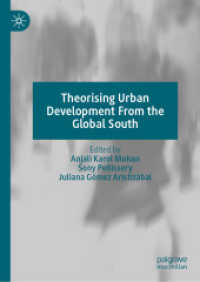- ホーム
- > 洋書
- > ドイツ書
- > Humanities, Arts & Music
- > History
- > antiquity
Full Description
This book probes the materiality of Improvement in early 19th century rural Massachusetts. Improvement was a metaphor for human intervention in the dramatic changes taking place to the English speaking world in the 18th and 19th centuries as part of a transition to industrial capitalism. The meaning of Improvement vacillated between ideas of economic profit and human betterment, but in practice, Improvement relied on a broad assemblage of material things and spaces for coherence and enaction.
Utilizing archaeological data from the home of a wealthy farmer in rural Western Massachusetts, as well as an analysis of early Republican agricultural publications, this book shows how Improvement's twin meanings of profit and betterment unfolded unevenly across early 19th century New England. The Improvement movement in Massachusetts emerged at a time of great social instability, and served to ameliorate growing tensions between urban and rural socioeconomic life through a rationalization of space. Alongside this rationalization, Improvement also served to reshape rural landscapes in keeping with the social and economic processes of a modernizing global capitalism. But the contradictions inherent in such processes spurred and buttressed wealth inequality, ecological distress, and social dislocation.
Contents
Preface.- Part 1: Improvement as archaeological subject.- Chapter 1: Rural Life and Historical Archaeology.- Chapter 2: Improvement, Capitalism, and Landscape Change.- Part 2: Improving New England at the dawn of the 19th century.- Chapter 3: Rural New England in Time and Place.- Chapter 4: Improvement and Agriculture in Massachusetts at the dawn of the 19th century.- Chapter 5: Excavating the Yeoman: Materializing the idealized people and landscapes of Improvement literature.- Chapter 6: The E.H. Williams House.- Chapter 7: The Logic of Improvement in the Williams Yard.- Chapter 8: Manuring and the political economy of Improvement.- Chapter 9: Conclusion.- Appendix: The archaeology of the EH Williams House.





